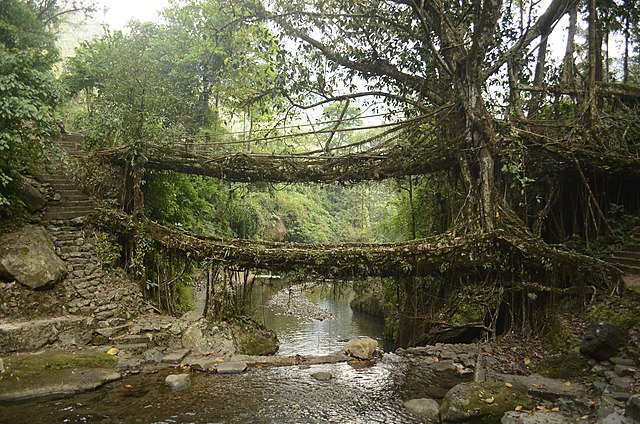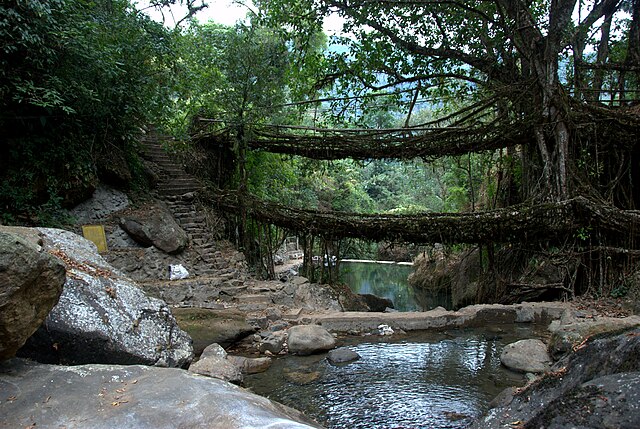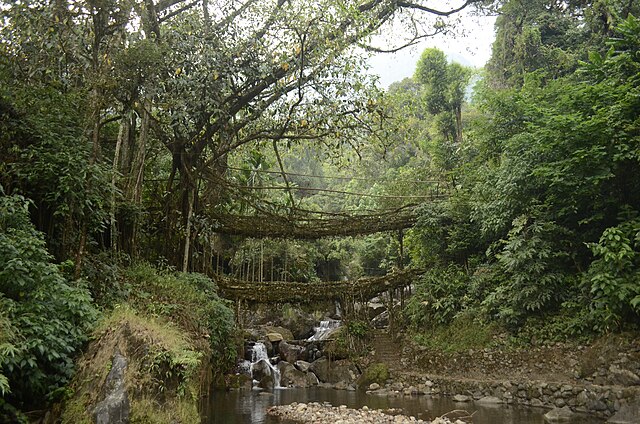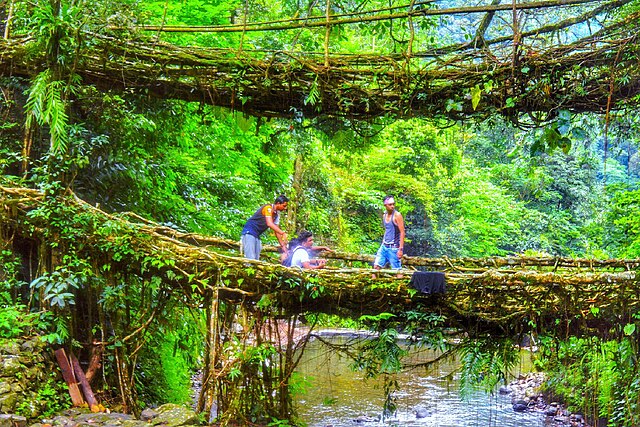What is the Double Decker Living Root Bridge?
Have you ever wondered what happens when nature and human ingenuity work together for centuries? The Double Decker Living Root Bridge in Meghalaya, India, is your answer. This isn’t just any ordinary bridge – it’s a living, breathing marvel that grows stronger with time.
Located in the village of Nongriat in the East Khasi Hills, this extraordinary structure is exactly what its name suggests: a bridge with two levels, both made entirely from the living roots of rubber trees. Unlike concrete or steel bridges that deteriorate over time, this natural wonder actually becomes more robust as the years pass.
The bridge spans across a crystal-clear stream in the heart of Meghalaya’s rainforest, creating a scene so surreal it feels like stepping into a fairy tale. What makes it even more remarkable is that it was grown, not built, by the indigenous Khasi people using traditional knowledge passed down through generations.
The Fascinating History Behind This Natural Wonder
The story of the Double Decker Living Root Bridge begins over 180 years ago. Can you imagine having the patience to start a project that your great-great-grandchildren would complete? That’s exactly what the Khasi ancestors did.
The bridge’s creation started in the early 19th century when the Khasi people recognized the need for a permanent river crossing that could withstand the region’s heavy monsoons. Traditional wooden or bamboo bridges would rot or get washed away, but the ingenious locals had a different idea.
They began training the aerial roots of Ficus elastica trees (Indian rubber trees) to grow across the stream. The process was painstakingly slow – taking decades for the roots to reach the other side and many more years to strengthen into a usable bridge.
What’s truly fascinating is that the double-decker design wasn’t the original plan. The upper level was added later when the community realized they could maximize the bridge’s functionality by creating a second tier. This demonstrates the adaptive and forward-thinking nature of traditional engineering.
Location and Geography of the Double Decker Bridge

Nestled in the East Khasi Hills district of Meghalaya, the Double Decker Living Root Bridge sits in Nongriat village, approximately 3 kilometers from Tyrna village. The bridge is part of the larger Cherrapunji region, famous for being one of the wettest places on Earth.
The geographical location is crucial to understanding why living root bridges exist here. Meghalaya receives over 450 inches of rainfall annually, creating conditions where traditional bridges would struggle to survive. The region’s topography, with its deep valleys and rushing streams, made river crossings particularly challenging for local communities.
The bridge spans a width of approximately 50 feet and stands about 2,400 feet above sea level. The surrounding landscape is a biodiversity hotspot, featuring dense subtropical forests, cascading waterfalls, and unique geological formations that make the journey as spectacular as the destination itself.
The area falls within the Meghalaya subtropical forests ecoregion, characterized by high humidity, rich soil, and diverse flora and fauna. This environment provides the perfect conditions for the rubber trees to thrive and develop the strong, flexible root systems necessary for bridge construction.
How Living Root Bridges Are Created
The creation of living root bridges is an art form that requires incredible patience, skill, and understanding of nature’s processes. So how exactly do you grow a bridge? The process is more fascinating than you might imagine.
It all starts with planting Ficus elastica trees on both sides of a river or stream. These trees are chosen specifically because they produce strong, flexible aerial roots that can be guided and shaped. The Khasi people have perfected this technique over centuries, turning tree cultivation into architectural engineering.
The Khasi Tribe’s Ancient Engineering Wisdom
The Khasi people didn’t stumble upon this technique by accident. Their deep understanding of local ecology, combined with practical necessity, led to this innovative solution. They observed how rubber tree roots naturally seek water sources and used this behavior to their advantage.
The process begins by identifying young rubber trees with promising root systems. The tree planters then use bamboo scaffolding and guidance systems to direct the growing roots toward the opposite bank. This requires constant monitoring and adjustment – imagine being a bridge architect where your building materials have a mind of their own!
The Khasi engineering wisdom extends beyond just growing bridges. They’ve developed sophisticated techniques for root weaving, strengthening weak sections, and even creating handrails and steps from smaller roots. This knowledge is passed down orally from generation to generation, making each bridge a repository of cultural heritage.
Growth Process: From Seedling to Bridge
The journey from seedling to functional bridge spans decades, sometimes even a century. In the first phase, which lasts 10-15 years, the trees establish their root systems and begin producing aerial roots. During this time, the community carefully guides these roots using bamboo tubes and frames.
The second phase involves the actual bridging process. As the roots reach across the water, they’re encouraged to intertwine and strengthen. This phase can take another 10-20 years before the bridge becomes sturdy enough for human use.
The final phase is ongoing maintenance and strengthening. Unlike man-made structures that require repairs, living root bridges actually improve with age. The roots continue growing and thickening, creating an increasingly robust structure that can support heavier loads over time.
Unique Features of the Double Decker Structure
What sets the Double Decker Living Root Bridge apart from other living root bridges isn’t just its two-tier design – it’s the incredible engineering solutions that make this design possible. The structure demonstrates an advanced understanding of load distribution, natural architecture, and sustainable construction.
Two-Level Design: Why It Matters
The double-decker design isn’t just about aesthetics or novelty – it serves several practical purposes. The upper level provides a dry crossing during monsoon seasons when the lower stream level might be flooded or dangerous. This dual-level approach ensures year-round accessibility for the local community.
The two-tier structure also allows for different types of traffic. The lower level, being closer to the water, is often used for activities like fishing or collecting water, while the upper level serves as the main pedestrian thoroughfare. This functional separation maximizes the bridge’s utility.
From an engineering perspective, the double-decker design distributes weight more effectively than a single-level bridge. The interconnected root systems on both levels create a complex network that can handle varying loads and stresses, making the entire structure more resilient.
Structural Strength and Durability
Don’t let the organic appearance fool you – this bridge is incredibly strong. The Double Decker Living Root Bridge can support the weight of 50 people at once, which is remarkable considering it’s made entirely of living plant material.
The secret lies in the root structure’s complexity. Unlike a single beam or cable, the bridge consists of hundreds of intertwined roots that distribute load across the entire system. If one root breaks or weakens, the others compensate, creating a self-healing and adaptive structure.
The durability aspect is perhaps even more impressive. While steel bridges rust and concrete crumbles, living root bridges actually grow stronger over time. The constant growth and adaptation mean that these bridges can theoretically last forever with proper care and maintenance.
Environmental Benefits
The environmental advantages of living root bridges extend far beyond their sustainable construction method. These structures actively contribute to ecosystem health while serving their transportation function.
The bridges help prevent soil erosion by stabilizing riverbanks with their extensive root systems. They also provide habitat corridors for various species, allowing animals to move between different forest areas without having to cross dangerous streams.
Additionally, the trees that form the bridges continue to perform all their natural functions – producing oxygen, absorbing carbon dioxide, and supporting local biodiversity. This makes them carbon-negative infrastructure, actually improving environmental conditions rather than degrading them.
How to Reach the Double Decker Living Root Bridge

Getting to the Double Decker Living Root Bridge is an adventure in itself, requiring both physical preparation and careful planning. The journey involves multiple transportation modes and a challenging trek that’s not for the faint-hearted.
The most common route starts from Shillong, Meghalaya’s capital city. From Shillong, you’ll travel approximately 60 kilometers to Tyrna village, which serves as the starting point for the trek. This drive takes about 2-3 hours on winding mountain roads that offer stunning views of the Khasi Hills.
From Tyrna, the real adventure begins. You’ll need to descend about 3,000 steps carved into the hillside – yes, you read that correctly, three thousand steps! This descent takes most people 1-2 hours, depending on fitness level and how often you stop to catch your breath or take photos.
Trek Details and Difficulty Level
The trek to the Double Decker Living Root Bridge is classified as moderate to difficult, primarily due to the steep descent and even more challenging ascent on the return journey. The path is well-maintained but can be slippery during monsoon season, requiring proper footwear and caution.
The total distance from Tyrna to the bridge is approximately 3 kilometers, but don’t let that fool you into thinking it’s a short walk. The elevation change is significant, and the terrain varies from stone steps to forest paths to stream crossings.
Most trekkers take 2-3 hours to reach the bridge and another 3-4 hours for the return journey. The return climb is particularly challenging as you’re ascending those 3,000 steps, often in humid conditions. Many visitors underestimate this aspect and find themselves exhausted halfway up.
It’s essential to carry adequate water, wear appropriate trekking shoes, and consider your fitness level before attempting this trek. The path can be particularly treacherous during heavy rains, so checking weather conditions beforehand is crucial.
Best Time to Visit
Timing your visit to the Double Decker Living Root Bridge can make the difference between an amazing experience and a challenging ordeal. The region’s climate varies dramatically throughout the year, affecting both accessibility and comfort.
The ideal time to visit is during the post-monsoon and winter months, from October to April. During this period, the weather is relatively dry, making the trek safer and more enjoyable. The reduced rainfall also means clearer views and better photography opportunities.
The monsoon season (May to September) presents both challenges and unique experiences. While the trek becomes more difficult and potentially dangerous due to slippery paths and swollen streams, this is when the forest is at its most lush and vibrant. The bridges and surrounding vegetation look their absolute best during this time.
Avoid visiting during peak monsoon months (June-August) unless you’re an experienced trekker comfortable with challenging conditions. Even then, always check local weather forecasts and consult with local guides about current trail conditions.
What to Expect During Your Visit
Your visit to the Double Decker Living Root Bridge will be unlike any other travel experience. From the moment you begin the descent from Tyrna, you’re entering a world where nature and human ingenuity have created something truly magical.
The initial descent through the forest is an experience in itself. You’ll pass through several smaller villages, encounter other living root bridges, and witness the incredible biodiversity of the Meghalaya forests. Keep your eyes open for exotic birds, butterflies, and if you’re lucky, some of the region’s unique mammals.
As you approach the main attraction, the anticipation builds. Then, suddenly, you’ll catch your first glimpse of the Double Decker Living Root Bridge through the forest canopy, and it’s a moment that takes your breath away. The structure seems almost mythical, like something from a fantasy novel brought to life.
Photography Tips and Guidelines
The Double Decker Living Root Bridge offers incredible photography opportunities, but capturing its essence requires some planning and technique. The bridge’s location in a forested valley means lighting conditions can be challenging, with dappled sunlight filtering through the canopy.
For the best photos, visit during the golden hours – early morning or late afternoon when the light is softer and more dramatic. The contrast between the organic bridge structure and the surrounding forest creates compelling compositions from multiple angles.
Consider bringing a wide-angle lens to capture the full scope of the bridge and its surroundings. The two-tier structure offers unique perspective opportunities – try shooting from below to emphasize the engineering marvel, or from the side to show the bridge’s integration with the natural environment.
Respect the bridge and local environment while photographing. Avoid damaging roots or vegetation for the perfect shot, and be considerate of other visitors who also want to experience and photograph this wonder.
Safety Precautions for Visitors

Safety should be your top priority when visiting the Double Decker Living Root Bridge. The combination of challenging terrain, living infrastructure, and remote location requires careful preparation and constant awareness.
The bridge itself, while strong, is still a living structure that can be slippery when wet. Move carefully and deliberately, especially on the root surfaces. The bridge doesn’t have traditional handrails, so maintain your balance and avoid sudden movements.
During the trek, stay hydrated and recognize your limits. The high humidity and physical exertion can lead to heat exhaustion, especially during the challenging return climb. Take regular breaks and don’t hesitate to turn back if conditions become unsafe.
Always inform someone about your travel plans and expected return time. Cell phone coverage is limited in the area, so having a predetermined check-in plan is essential for safety.
Conservation Efforts and Sustainable Tourism
The increasing popularity of the Double Decker Living Root Bridge brings both opportunities and challenges for conservation. Balancing tourism benefits with environmental protection requires careful management and community involvement.
Local communities have implemented several measures to protect the bridge and surrounding ecosystem. These include visitor limits during sensitive periods, designated pathways to minimize environmental impact, and education programs to raise awareness about the bridge’s cultural and ecological significance.
The Meghalaya government, in partnership with local organizations, has developed sustainable tourism guidelines that aim to preserve these natural wonders for future generations. These efforts include waste management programs, trail maintenance initiatives, and support for local guides and communities.
Visitors play a crucial role in conservation efforts. By following designated paths, respecting local customs, carrying out all trash, and supporting local businesses, tourists can contribute positively to the bridge’s preservation and the community’s economic well-being.
Other Living Root Bridges in Meghalaya
While the Double Decker Living Root Bridge is the most famous, Meghalaya is home to numerous other living root bridges, each with its own unique characteristics and cultural significance. Exploring these other bridges provides a deeper understanding of this remarkable engineering tradition.
The Single Decker Living Root Bridge near Riwai village offers a less challenging trek while still providing an authentic experience. The Umshiang Double Decker Root Bridge provides an alternative to the more crowded Nongriat bridge, offering similar engineering marvels with fewer visitors.
The Mawlynnong area features several smaller living root bridges that showcase different construction techniques and stages of development. These bridges demonstrate the widespread nature of this traditional practice throughout Khasi territory.
Each bridge tells its own story of community cooperation, environmental adaptation, and traditional knowledge. Visiting multiple bridges provides insight into the variations and innovations within this ancient engineering practice.
Cultural Significance and Local Communities
The Double Decker Living Root Bridge represents far more than just a river crossing – it embodies the cultural identity, traditional knowledge, and community values of the Khasi people. Understanding this cultural context enriches the visitor experience and highlights the importance of preserving both the physical structure and the knowledge systems that created it.
For the Khasi community, these bridges represent a connection between generations. The planning, creation, and maintenance of living root bridges requires long-term thinking and community cooperation that spans decades. Children grow up learning about bridge care, continuing traditions that connect them to their ancestors.
The bridges also demonstrate the Khasi philosophy of living in harmony with nature rather than conquering it. This worldview, increasingly relevant in our age of environmental challenges, offers valuable lessons about sustainable development and ecological wisdom.
Supporting local communities through responsible tourism helps ensure that traditional knowledge and practices continue to thrive. When visitors engage respectfully with local guides, stay in community-run accommodations, and purchase local products, they contribute to the economic viability of maintaining these cultural practices.
Conclusion
The Double Decker Living Root Bridge stands as a testament to human ingenuity, patience, and harmony with nature. This remarkable structure challenges our assumptions about engineering, sustainability, and the relationship between traditional knowledge and modern needs.
More than just a tourist attraction, the bridge represents a living example of how communities can create infrastructure that strengthens rather than damages the environment. In an era of climate change and environmental degradation, the wisdom embedded in these living bridges offers hope and practical solutions for sustainable development.
Your visit to this natural wonder will likely change your perspective on what’s possible when humans work with nature rather than against it. The physical challenge of reaching the bridge, the awe of seeing this living architecture, and the cultural insights gained from the experience combine to create memories that last a lifetime.
As you plan your journey to this incredible destination, remember that you’re not just visiting a bridge – you’re witnessing centuries of accumulated wisdom, participating in sustainable tourism, and supporting communities that have created one of the world’s most remarkable examples of bio-engineering.
FAQs
1. How long does it take to complete the trek to the Double Decker Living Root Bridge?
The complete trek typically takes 5-7 hours round trip. The descent to the bridge takes 1.5-2.5 hours, depending on your fitness level and how often you stop. You’ll want to spend at least 1-2 hours at the bridge itself to fully appreciate it and rest before the return journey. The ascent back to Tyrna village is more challenging and usually takes 3-4 hours, as you’re climbing uphill for most of the way.
2. Is the Double Decker Living Root Bridge safe for children and elderly visitors?
The trek requires a moderate to high fitness level and involves navigating steep, sometimes slippery terrain. While the bridge itself is structurally sound, the journey to reach it can be challenging for children under 10 and elderly visitors with mobility issues. If you’re traveling with children or elderly family members, carefully assess their fitness levels and consider shorter alternatives like the Single Decker bridges that require less strenuous treks.
3. What should I pack for the trek to the living root bridge?
Essential items include sturdy trekking shoes with good grip, plenty of water (at least 2-3 liters per person), energy snacks, a first aid kit, and waterproof bags for electronics. During monsoon season, pack rainwear and extra clothing. Don’t forget sunscreen, insect repellent, and a power bank for your camera. A walking stick can be helpful for the steep sections, and wearing moisture-wicking clothing will keep you more comfortable during the humid trek.
4. Can I visit the Double Decker Living Root Bridge during monsoon season?
While it’s possible to visit during monsoon season (May-September), it’s significantly more challenging and potentially dangerous. The paths become extremely slippery, stream water levels rise, and visibility can be poor due to fog and rain. However, this is when the forest is most lush and the bridges look their most spectacular. If you do visit during monsoons, hire an experienced local guide, check weather conditions daily, and be prepared for potentially hazardous trekking conditions.
5. Are there accommodation options near the Double Decker Living Root Bridge?
Yes, there are several accommodation options ranging from basic guesthouses to eco-friendly homestays. Nongriat village offers simple accommodations where you can experience local Khasi hospitality. Tyrna village, the trek starting point, has basic lodges and homestays. For more comfortable options, consider staying in Cherrapunji (about 45 minutes away) which offers a wider range of hotels and resorts. Many trekkers prefer to make it a two-day trip, staying overnight near the bridge to avoid the challenging same-day return journey.

